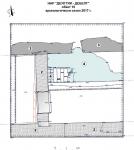Summary (English)
DEULTUM (Lyudmil Vagalinski – lvagalin@techno-link.com) In Site 10, the explorations of the northwestern corner of the Late Antique fortification wall continued. The strata were c. 5 m thick. There were traces from fire on the earliest occupation level dated after AD 161 that probably occurred during the Marcomannic Wars when the Costoboci invaded the Roman provinces in the Balkans. A water-conduit of terracotta pipes was the only structure of that period. After AD 161 and before AD 268, a monumental building was constructed, some parts of it built in opus mixtum. The walls discovered in the neighboring Site 9 were built in the same technique and had arches; a hypocaust was also documented. These structures probably belonged to one and the same large architectural complex, probably a villa urbana. It was burned down after AD 268, probably by the Goths and subsequently, the northern fortification wall with a monumental tower in the middle was built before AD 383. Two consecutive attacks were documented: after AD 383 and after AD 395, probably carried out by the Goths and/or by the Huns. The latter one was probably the same attack documented on Site 9 that occurred after AD 402/450. After AD 457/474 and before AD 491/518, the northern fortification wall was reinforced with another wall that adjoined its inner southern side. The new Early Byzantine fortress significantly decreased the fortified area of Deultum from the east and from the west. The fortress survived an attack that occurred after AD 491/518, but it was burned down soon after AD 574, probably during the invasions of Avars and Slavs. Subsequently, a small fortress was built on a hill at c. 1 km to the southwest. It was probably conquered by the proto-Bulgarian Khan Krum in AD 812. Judging from the pottery, the small fortress existed until the beginning of the 13th century when it was destroyed by the Crusaders who conquered Constantinople. During the 7th – 8th centuries AD, ramshackle houses were built over the debris of the northern fortification wall of Deultum and subsequently, they were burned down.
- Lyudmil Vagalinski - Archaeological Institute with Museum
Director
Team
Research Body
- Archaeological Institute with Museum






![Download [PDF]](/excavation/skins/fasti/images/results/download_sml.png)
